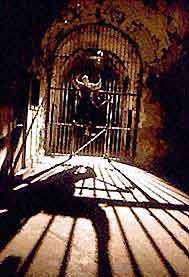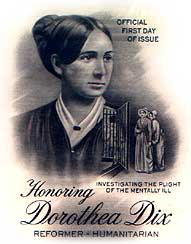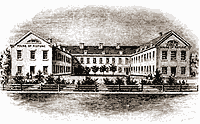26d. Prison and Asylum Reform

The pretty woman who stood before the all-male audience seemed unlikely to provoke controversy. Tiny and timid, she rose to the platform of the Massachusetts Legislature to speak. Those who had underestimated the determination and dedication of Dorothea Dix, however, were brought to attention when they heard her say that the sick and insane were "confined in this Commonwealth in cages, closets, cellars, stalls, pens! Chained, beaten with rods, lashed into obedience." Thus, her crusade for humane hospitals for the insane, which she began in 1841, was reaching a climax. After touring prisons, workhouses, almshouses, and private homes to gather evidence of appalling abuses, she made her case for state-supported care. Ultimately, she not only helped establish five hospitals in America, but also went to Europe where she successfully pleaded for human rights to Queen Victoria and the Pope.

Dorothea Dix, a tireless crusader for the treatment of the mentally ill, was made the Superintendent of Nurses for the Union Army during the Civil War. After the war, she retired to an apartment in the first hospital that she had founded, in Trenton, New Jersey.
The year 1841 also marked the beginning of the superintendence of Dr. John Galt at Eastern Lunatic Asylum, in Williamsburg, Virginia, the first publicly supported psychiatric hospital in America. Warehousing of the sick was primary; their care was not. Dr. Galt had many revolutionary ideas about treating the insane, based on his conviction that they had dignity. Among his enlightened approaches were the use of drugs, the introduction of "talk therapy" and advocating outplacement rather than lifelong stays.
In addition to the problems in asylums, prisons were filled to overflowing with everyone who gave offense to society from committing murder to spitting on the street. Men, women, children were thrown together in the most atrocious conditions. Something needed to be done — but what?

Until the 19th century, juveniles offenders were passed into the custody of their parents. During the time of prison and asylum reform, juvenile detention centers like the House of Refuge in New York were built to reform children of delinquent behavior.
After the War of 1812, reformers from Boston and New York began a crusade to remove children from jails into juvenile detention centers. But the larger controversy continued over the purpose of prison — was it for punishment or penitence? In 1821, a disaster occurred in Auburn Prison that shocked even the governor into pardoning hardened criminals. After being locked down in solitary, many of the eighty men committed suicide or had mental breakdowns. Auburn reverted to a strict disciplinary approach. The champion of discipline and first national figure in prison reform was Louis Dwight. founder of the Boston Prison Discipline Society, he spread the Auburn system throughout America's jails and added salvation and Sabbath School to further penitence.
After several bad starts, America finally enjoyed about a decade of real reform. Idealism, plus hope in the perfectibility of institutions, spurred a new generation of leaders including Francis Lieber, Samuel Gridley Howe and the peerless Dix. Their goals were prison libraries, basic literacy (for Bible reading), reduction of whipping and beating, commutation of sentences, and separation of women, children and the sick.
By 1835, America was considered to have two of the "best" prisons in the world in Pennsylvania. Astonishingly, reformers from Europe looked to the new nation as a model for building, utilizing and improving their own systems. Advocates for prisoners believed that deviants could change and that a prison stay could have a positive effect. It was a revolutionary idea in the beginning of the 19th century that society rather than individuals had the responsibility for criminal activity and had the duty to treat neglected children and rehabilitate alcoholics.
In reality it became clear that, despite intervention by outsiders, prisoners were often no better off, and often worse off, for their incarceration. Yet, in keeping with the optimistic spirit of the era, these early reformers had only begun a crusade to alleviate human suffering that continues today.






